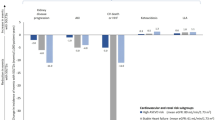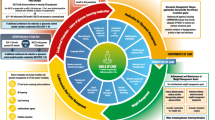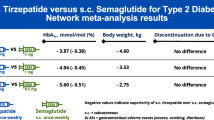Abstract
Introduction
While several sodium glucose co-transporter 2 (SGLT2) inhibitors are approved as an adjunct to diet and exercise to improve glycemic control in patients with type 2 diabetes mellitus (T2DM), there are no clinical trial data providing head-to-head comparisons of the efficacy and safety of these therapies. Real-world analyses can provide valuable evidence on the effectiveness of competing treatments. This study compared the real-world glycemic effectiveness of SGLT2 inhibitors in individuals with T2DM.
Methods
Patients who initiated canagliflozin 300 mg versus empagliflozin 25 mg or dapagliflozin 10 mg were identified from the Optum® De-identified Clinformatics® Extended Data Mart–Date of Death database and propensity score matched. Achievement of HbA1c < 8.0% (Healthcare Effectiveness Data and Information Set [HEDIS] target) and > 9.0% (HEDIS poor control) after 6 months of treatment was calculated.
Results
Post-baseline HbA1c was similar in the canagliflozin and empagliflozin cohorts (7.65% versus 7.57%), as was percent of patients with HbA1c < 8.0% or > 9.0%. Post-baseline HbA1c was lower with canagliflozin versus dapagliflozin (7.58% versus 7.74%; P = 0.0247). The canagliflozin cohort was more likely to achieve HbA1c < 8.0% than the dapagliflozin cohort (P = 0.0292); the likelihood of achieving HbA1c > 9.0% was similar.
Conclusion
In patients with T2DM, HbA1c outcomes were similar with canagliflozin and empagliflozin. Patients on canagliflozin versus dapagliflozin were more likely to have a lower HbA1c and reach HbA1c < 8.0% after 6 months. These results may provide important information for clinicians as they decide the appropriate treatment for their patients with T2DM.



Similar content being viewed by others
References
Centers for Disease Control and Prevention. National Diabetes Statistics Report, 2020. Atlanta: Centers for Disease Control and Prevention, US Dept of Health and Human Services; 2020. https://www.cdc.gov/diabetes/pdfs/data/statistics/national-diabetes-statistics-report.pdf. Accessed May 1, 2020.
Lin J, Thompson TJ, Cheng YJ, et al. Projection of the future diabetes burden in the United States through 2060. Popul Health Metr. 2018;16:9.
American Diabetes Association. 1. Improving care and promoting health in populations: Standards of Medical Care in Diabetes—2019. Diabetes Care. 2019;42:S7–12.
American Diabetes Association. Economic costs of diabetes in the US in 2017. Diabetes Care. 2018;41:917–28.
Fallon Health. 2018 Healthcare Effectiveness Data and Information Set (HEDIS®) measures. https://www.fchp.org/providers/resources/hedis-measures.aspx. Accessed May 1, 2018.
Garber AJ, Handelsman Y, Grunberger G, et al. Consensus statement by the American Association of Clinical Endocrinologists and American College of Endocrinology on the comprehensive type 2 diabetes management algorithm—2020 executive summary. Endocr Pract. 2020;26:107–39.
Davies MJ, D’Alessio DA, Fradkin J, et al. Management of hyperglycemia in type 2 diabetes, 2018. A consensus report by the American Diabetes Association (ADA) and the European Association for the Study of Diabetes (EASD). Diabetes Care. 2018;41:2669–701.
Bennett WL, Maruthur NM, Singh S, et al. Comparative effectiveness and safety of medications for type 2 diabetes: an update including new drugs and 2-drug combinations. Ann Intern Med. 2011;154:602–13.
Gross JL, Kramer CK, Leitão CB, et al. Effect of antihyperglycemic agents added to metformin and a sulfonylurea on glycemic control and weight gain in type 2 diabetes: a network meta-analysis. Ann Intern Med. 2011;154:672–9.
Maruthur NM, Tseng E, Hutfless S, et al. Diabetes medications as monotherapy or metformin-based combination therapy for type 2 diabetes: a systematic review and meta-analysis. Ann Intern Med. 2016;164:740–51.
Rosenthal N, Meininger G, Ways K, et al. Canagliflozin: a sodium glucose co-transporter 2 inhibitor for the treatment of type 2 diabetes mellitus. Ann N Y Acad Sci. 2015;1358:28–43.
INVOKANA® (canagliflozin) tablets, for oral use [package insert]. Titusville: Janssen Pharmaceuticals; 2018.
FARXIGA® (dapagliflozin) [package insert]. Wilmington: AstraZeneca Pharmaceuticals; 2017.
JARDIANCE® (empagliflozin) [package insert]. Ridgefield: Boehringer Ingelheim Pharmaceuticals; 2017.
STEGLATRO™ (ertugliflozin) [package insert]. Whitehouse Station: Merck Sharp and Dohme Corp; 2017.
Mestre-Ferrandiz J, Sussex J, Towse A. The R&D Cost of a New Medicine. London: Office of Health Economics; 2012.
Zaccardi F, Webb DR, Htike ZZ, Youssef D, Khunti K, Davies MJ. Efficacy and safety of sodium-glucose co-transporter 2 inhibitors in type 2 diabetes mellitus: systematic review and network meta-analysis. Diabetes Obes Metab. 2016;18:783–94.
Whittington C, Schubert A, Neslusan C. An assessment of the relative efficacy of sodium glucose co-transporter 2 inhibitors as add-on to metformin in patients with type 2 diabetes mellitus. Poster presented at: International Society for Pharmacoeconomics and Outcomes Research (ISPOR) 19th Annual European Congress; October 29–November 2, 2016; Vienna.
Blonde L, Patel C, Bookhart B, Pfeifer M, Chen YW, Wu B. A real-world analysis of glycemic control among patients with type 2 diabetes treated with canagliflozin versus dapagliflozin. Curr Med Res Opin. 2018;34:1143–52.
Sha S, Polidori D, Farrell K, et al. Pharmacodynamic differences between canagliflozin and dapagliflozin: results of a randomized, double-blind, crossover study. Diabetes Obes Metab. 2015;17:188–97.
Polidori D, Sha S, Mudaliar S, et al. Canagliflozin lowers postprandial glucose and insulin by delaying intestinal glucose absorption in addition to increasing urinary glucose excretion: results of a randomized, placebo-controlled study. Diabetes Care. 2013;36:2154–61.
Invokana (300 mg film-coated tablets), [package insert]. Beerse, Belgium; Janssen-Cilag International NV; 2017.
FORXIGA® (dapagliflozin) tablets for oral use [summary of product characteristics]. London: AstraZeneca; 2014.
Heise T, Seewaldt-Becker E, Macha S, et al. Safety, tolerability, pharmacokinetics and pharmacodynamics following 4 weeks’ treatment with empagliflozin once daily in patients with type 2 diabetes. Diabetes Obes Metab. 2013;15:613–21.
Cai J, Wang Y, Baser O, Xie L, Chow W. Comparative persistence and adherence with newer anti-hyperglycemic agents to treat patients with type 2 diabetes in the United States. J Med Econ. 2016;19:1175–86.
Cai J, Divino V, Burudpakdee C. Adherence and persistence in patients with type 2 diabetes mellitus newly initiating canagliflozin, dapagliflozin, dpp-4s, or glp-1s in the United States. Curr Med Res Opin. 2017;33:1317–28.
Andersson C, van Gaal L, Caterson ID, et al. Relationship between HbA1c levels and risk of cardiovascular adverse outcomes and all-cause mortality in overweight and obese cardiovascular high-risk women and men with type 2 diabetes. Diabetologia. 2012;55:2348–55.
Einarson TR, Acs A, Ludwig C, Panton UH. Prevalence of cardiovascular disease in type 2 diabetes: a systematic literature review of scientific evidence from across the world in 2007–2017. Cardiovasc Diabetol. 2018;17:83.
Zhuo X, Zhang P, Hoerger TJ. Lifetime direct medical costs of treating type 2 diabetes and diabetic complications. Am J Prev Med. 2013;45:253–61.
Neal B, Perkovic V, Mahaffey KW, et al. Canagliflozin and cardiovascular and renal events in type 2 diabetes. N Engl J Med. 2017;377:644–57.
Perkovic V, Jardine MJ, Neal B, et al. Canagliflozin and renal outcomes in type 2 diabetes and nephropathy. N Engl J Med. 2019;380:2295–306.
Zinman B, Wanner C, Lachin JM, et al. Empagliflozin, cardiovascular outcomes, and mortality in type 2 diabetes. N Engl J Med. 2015;373:2117–28.
Wanner C, Inzucchi SE, Zinman B. Empagliflozin and progression of kidney disease in type 2 diabetes. N Engl J Med. 2016;375:1801–2.
Wiviott SD, Raz I, Bonaca MP, et al. Dapagliflozin and cardiovascular outcomes in type 2 diabetes. N Engl J Med. 2019;380:347–57.
Mosenzon O, Wiviott SD, Cahn A, et al. Effects of dapagliflozin on development and progression of kidney disease in patients with type 2 diabetes: an analysis from the DECLARE-TIMI 58 randomised trial. Lancet Diabetes Endocrinol. 2019;7:606–17.
Acknowledgements
Funding
Sponsorship for this study and the journal’s Rapid Service Fee were funded by Janssen Scientific Affairs, LLC (Titusville, NJ, USA). Canagliflozin has been developed by Janssen Research & Development, LLC in collaboration with Mitsubishi Tanabe Pharma Corporation (Chūō-ku, Japan).
Medical Writing, Editorial, and Other Assistance
The authors thank Deepti Bisht of Mu Sigma for data programming support and Michael Pfeifer of Janssen Scientific Affairs, LLC for helpful discussions. Medical writing support was provided by Dana Tabor, PhD, of MedErgy, and was funded by Janssen Scientific Affairs, LLC.
Authorship
All named authors meet the International Committee of Medical Journal Editors (ICMJE) criteria for authorship for this article, take responsibility for the integrity of the work as a whole, and have given their approval for this version to be published.
Disclosures
Lawrence Blonde has served as an investigator for Janssen Pharmaceuticals Inc., Lexicon Pharmaceuticals Inc., Merck & Co., Novo Nordisk, and Sanofi; has served as a speaker for Janssen Pharmaceuticals Inc., Novo Nordisk, and Sanofi; and has served as a consultant for AstraZeneca, Gilead Sciences Inc., Janssen Pharmaceuticals Inc., Merck & Co., Novo Nordisk, and Sanofi. Charmi Patel, Bingcao Wu, Yen-Wen Chen, Christopher D. Pericone, and Brahim Bookhart are employees of Janssen Scientific Affairs, LLC. Charmi Patel and Brahim Bookhart own stock in Johnson & Johnson.
Compliance with Ethics Guidelines
This study is based on de-identified data collected from a health care claims database and does not contain any experimental data with human or animal participants; this analysis was deemed exempt from institutional review board oversight and informed consent was not obtained.
Data Availability
Data for this study were available to the authors via third-party license from Optum, a commercial data provider in the US, and Janssen Pharmaceuticals, which has a license for analysis of the de-identified Optum Clinformatics Extended Data Mart–Date of Death Database. As such, the authors cannot provide the raw data; however, other researchers may access the data by purchase through Optum, and the inclusion criteria specified in the methods would allow them to identify the same cohort of patients. Interested individuals may visit http://www.optum.com/contact.html for more information on accessing Optum Clinformatics Extended Data Mart–Date of Death Database.
Author information
Authors and Affiliations
Corresponding author
Electronic supplementary material
Below is the link to the electronic supplementary material.
Rights and permissions
About this article
Cite this article
Blonde, L., Patel, C., Wu, B. et al. Real-World Comparative Effectiveness of Canagliflozin Versus Empagliflozin and Dapagliflozin in Patients with Type 2 Diabetes in the United States. Adv Ther 38, 594–606 (2021). https://doi.org/10.1007/s12325-020-01549-x
Received:
Accepted:
Published:
Issue Date:
DOI: https://doi.org/10.1007/s12325-020-01549-x




